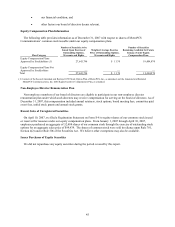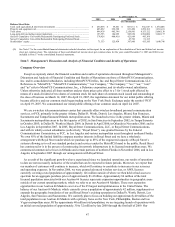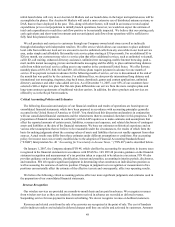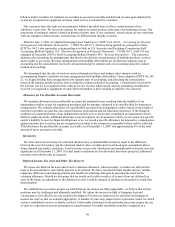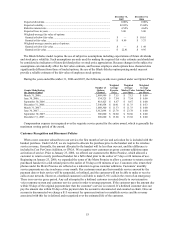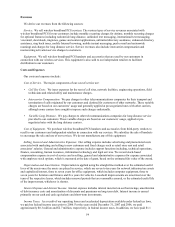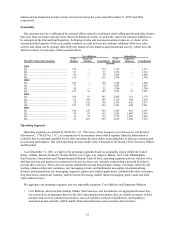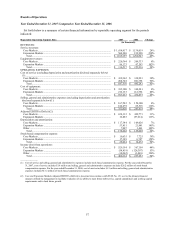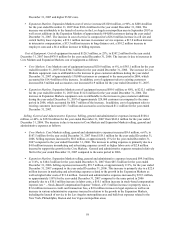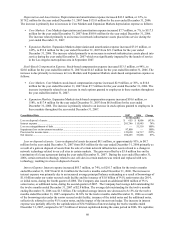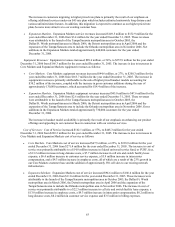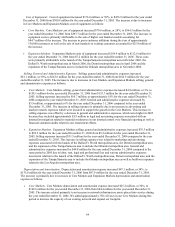Metro PCS 2007 Annual Report Download - page 66
Download and view the complete annual report
Please find page 66 of the 2007 Metro PCS annual report below. You can navigate through the pages in the report by either clicking on the pages listed below, or by using the keyword search tool below to find specific information within the annual report.
55
million and an immaterial amount of state income tax during the years ended December 31, 2007 and 2006,
respectively.
Seasonality
Our customer activity is influenced by seasonal effects related to traditional retail selling periods and other factors
that arise from our target customer base. Based on historical results, we generally expect net customer additions to
be strongest in the first and fourth quarters. Softening of sales and increased customer turnover, or churn, in the
second and third quarters of the year usually combine to result in fewer net customer additions. However, sales
activity and churn can be strongly affected by the launch of new markets and promotional activity, which have the
ability to reduce or outweigh certain seasonal effects.
Net Additions
Subscribers
MetroPCS Subscriber Statistics
Core
Markets
Expansion
Markets
Consolidated
Core
Markets
Expansion
Markets
Consolidated
(In 000s)
2004
Q1............................................................ 174 — 174 1,151 — 1,151
Q2............................................................ 63 — 63 1,214 — 1,214
Q3............................................................ 66 — 66 1,280 — 1,280
Q4............................................................ 119 — 119 1,399 — 1,399
2005
Q1............................................................ 169 — 169 1,568 — 1,568
Q2............................................................ 77 — 77 1,645 — 1,645
Q3............................................................ 95 — 95 1,740 — 1,740
Q4............................................................ 132 53 185 1,872 53 1,925
2006
Q1............................................................ 184 61 245 2,056 114 2,170
Q2............................................................ 63 186 249 2,119 300 2,419
Q3............................................................ 55 142 198 2,174 442 2,617
Q4............................................................ 127 198 324 2,301 640 2,941
2007
Q1............................................................ 184 270 454 2,485 910 3,395
Q2............................................................ 58 97 155 2,543 1,007 3,550
Q3............................................................ 36 78 114 2,578 1,086 3,664
Q4............................................................ 81 218 299 2,659 1,304 3,963
Operating Segments
Operating segments are defined by SFAS No. 131 “Disclosure About Segments of an Enterprise and Related
Information,” (“SFAS No. 131”), as components of an enterprise about which separate financial information is
available that is evaluated regularly by the chief operating decision maker in deciding how to allocate resources and
in assessing performance. Our chief operating decision maker is the Chairman of the Board, Chief Executive Officer
and President.
As of December 31, 2007, we had twelve operating segments based on geographic region within the United
States: Atlanta, Boston, Dallas/Ft. Worth, Detroit, Las Vegas, Los Angeles, Miami, New York, Philadelphia,
San Francisco, Sacramento and Tampa/Sarasota/Orlando. Each of these operating segments provide wireless voice
and data services and products to customers in its service areas or is currently constructing a network in order to
provide these services. These services include unlimited local and long distance calling, voicemail, caller ID, call
waiting, enhanced directory assistance, text messaging, picture and multimedia messaging, international long
distance and international text messaging, ringtones, games and content applications, unlimited directory assistance,
ring back tones, nationwide roaming, mobile Internet browsing, mobile instant messaging, push e-mail and other
value-added services.
We aggregate our operating segments into two reportable segments: Core Markets and Expansion Markets.
• Core Markets, which include Atlanta, Miami, San Francisco, and Sacramento, are aggregated because they
are reviewed on an aggregate basis by the chief operating decision maker, they are similar in respect to their
products and services, production processes, class of customer, method of distribution, and regulatory
environment and currently exhibit similar financial performance and economic characteristics.


